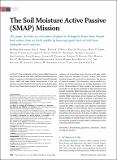The Soil Moisture Active Passive (SMAP) Mission
Author(s)
Entekhabi, Dara; Njoku, Eni G.; O'Neill, Peggy E.; Kellogg, Kent H.; Crow, Wade T.; Edelstein, Wendy N.; Entin, Jared K.; Goodman, Shawn D.; Jackson, Thomas J.; Johnson, Joel; Kimball, John; Piepmeier, Jeffrey R.; Koster, Randal D.; Martin, Neil; McDonald, Kyle C.; Moghaddam, Mahta; Moran, Susan; Reichle, Rolf; Shi, J. C.; Spencer, Michael W.; Thurman, Samuel W.; Tsang, Leung; Van Zyl, Jakob; ... Show more Show less
DownloadEntekhabi_The soil.pdf (1.731Mb)
PUBLISHER_POLICY
Publisher Policy
Article is made available in accordance with the publisher's policy and may be subject to US copyright law. Please refer to the publisher's site for terms of use.
Terms of use
Metadata
Show full item recordAbstract
The Soil Moisture Active Passive (SMAP) mission is one of the first Earth observation satellites being developed by NASA in response to the National Research Council's Decadal Survey. SMAP will make global measurements of the soil moisture present at the Earth's land surface and will distinguish frozen from thawed land surfaces. Direct observations of soil moisture and freeze/thaw state from space will allow significantly improved estimates of water, energy, and carbon transfers between the land and the atmosphere. The accuracy of numerical models of the atmosphere used in weather prediction and climate projections are critically dependent on the correct characterization of these transfers. Soil moisture measurements are also directly applicable to flood assessment and drought monitoring. SMAP observations can help monitor these natural hazards, resulting in potentially great economic and social benefits. SMAP observations of soil moisture and freeze/thaw timing will also reduce a major uncertainty in quantifying the global carbon balance by helping to resolve an apparent missing carbon sink on land over the boreal latitudes. The SMAP mission concept will utilize L-band radar and radiometer instruments sharing a rotating 6-m mesh reflector antenna to provide high-resolution and high-accuracy global maps of soil moisture and freeze/thaw state every two to three days. In addition, the SMAP project will use these observations with advanced modeling and data assimilation to provide deeper root-zone soil moisture and net ecosystem exchange of carbon. SMAP is scheduled for launch in the 2014-2015 time frame.
Date issued
2010-05Department
Massachusetts Institute of Technology. Department of Electrical Engineering and Computer ScienceJournal
Proceedings of the IEEE
Publisher
Institute of Electrical and Electronics Engineers
Citation
Entekhabi, D. et al. “The Soil Moisture Active Passive (SMAP) Mission.” Proceedings of the IEEE 98.5 (2010): 704-716. © Copyright 2010 IEEE
Version: Final published version
Other identifiers
INSPEC Accession Number: 11340724
ISSN
0018-9219